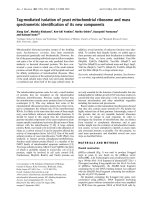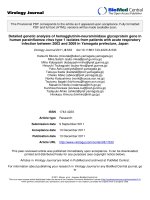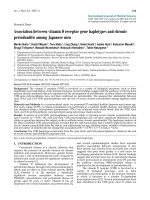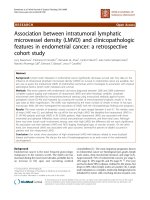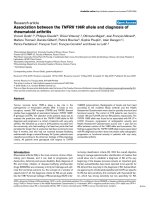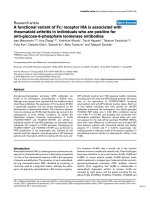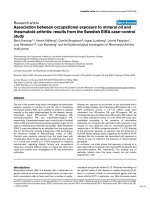Báo cáo y học: " Association between disruption of CD4 receptor dimerization and increased human immunodeficiency virus type 1 entry" pdf
Bạn đang xem bản rút gọn của tài liệu. Xem và tải ngay bản đầy đủ của tài liệu tại đây (387.89 KB, 8 trang )
BioMed Central
Page 1 of 8
(page number not for citation purposes)
Retrovirology
Open Access
Research
Association between disruption of CD4 receptor dimerization and
increased human immunodeficiency virus type 1 entry
Rachel Bourgeois
1
, Johanne Mercier
2
, Isabelle Paquette-Brooks
2
and
Éric A Cohen*
1
Address:
1
Department of Microbiology and Immunology, Université de Montréal, Montreal, Quebec, Canada and
2
Laboratory of Human
Retrovirology, Institut de Recherches Cliniques de Montréal, Montreal, Quebec, Canada
Email: Rachel Bourgeois - ; Johanne Mercier - ; Isabelle Paquette-
Brooks - ; Éric A Cohen* -
* Corresponding author
Abstract
Background: Human immunodeficiency virus (HIV) enters target cells by a membrane fusion
process that involves a series of sequential interactions between its envelope glycoproteins, the
CD4 receptor and CXCR4/CCR5 coreceptors. CD4 molecules are expressed at the cell surface
of lymphocytes and monocytes mainly as monomers, but basal levels of CD4 dimers are also
present at the cell surface of these cells. Previous evidence indicates that the membrane distal and
proximal extracellular domains of CD4, respectively D1 and D4, are involved in receptor
dimerization.
Results: Here, we have used A201 cell lines expressing two CD4 mutants, CD4-E91K, E92K (D1
mutant) and CD4-Q344E (D4 mutant), harboring dimerization defects to analyze the role of CD4
dimerization in HIV-1 entry. Using entry assays based on β-lactamase-Vpr or luciferase reporter
activities, as well as virus encoding envelope glycoproteins derived from primary or laboratory-
adapted strains, we obtained evidence suggesting an association between disruption of CD4
dimerization and increased viral entry efficiency.
Conclusion: Taken together, our results suggest that monomeric forms of CD4 are preferentially
used by HIV-1 to gain entry into target cells, thus implying that the dimer/monomer ratio at the
cell surface of HIV-1 target cells may modulate the efficiency of HIV-1 entry.
Background
HIV-1 is an enveloped virus that gains entry into target
cells by mediating the fusion of viral and cellular mem-
branes. The first step of this fusion process involves the
binding of gp120, the surface subunit of the viral enve-
lope glycoprotein (Env), to its primary receptor, CD4.
This interaction induces conformational changes in both
proteins that lead to subsequent binding of gp120 to its
coreceptor, CCR5 or CXCR4. Coreceptor binding is
thought to next trigger major structural rearrangements in
the transmembrane glycoprotein gp41 subunit, including
the formation of a triple-stranded coiled-coil that enables
the hydrophobic fusion peptide at the N-terminus of gp41
to insert into the target cell membrane. The triple-
stranded coiled-coil then bends back on itself, forming a
six helix bundle that brings the viral and target cell mem-
Published: 08 June 2006
Retrovirology 2006, 3:31 doi:10.1186/1742-4690-3-31
Received: 24 April 2006
Accepted: 08 June 2006
This article is available from: />© 2006 Bourgeois et al; licensee BioMed Central Ltd.
This is an Open Access article distributed under the terms of the Creative Commons Attribution License ( />),
which permits unrestricted use, distribution, and reproduction in any medium, provided the original work is properly cited.
Retrovirology 2006, 3:31 />Page 2 of 8
(page number not for citation purposes)
branes into close proximity and allows membrane fusion
(reviewed in reference [1]).
CD4 is a transmembrane glycoprotein that is mainly
expressed by T-lymphocytes, monocytes/macrophages
and dendritic cells. The CD4 receptor normally functions
as a coligand and coreceptor of the major histocompati-
bility complex class II (MHC II) molecule during T cell
recognition of a foreign antigen where, in fact, it stabilizes
the MHC II-peptide-T-cell receptor complex and initiates
intracellular signal transduction leading to T cell activa-
tion [2]. CD4 is predominantly expressed as a 55 kDa
monomer, but CD4 dimers and tetramers (110 and 220
kDa) have also been found to be expressed at the cell sur-
face of T lymphocytes and monocytes/macrophages [3-5].
The equilibrium established between these different
forms may vary according to the cell type, the activation
state of the cell and the redox conditions at the plasma
membrane [3,6,7]. For instance, binding of CD4 to its oli-
gomeric ligands, MHC II and gp120, is believed to induce
the formation of CD4 oligomers [8], which in turn, trigger
the activation of the CD4 cytoplasmic tail-associated tyro-
sine kinase p56
lck
, by trans-phosphorylation [9]. The sub-
sequent signaling cascade was found to induce the nuclear
translocation of the AP-1 and NF-κB transcription factors,
promoting T-cell activation [10].
The extracellular portion of CD4 is composed of four
immunoglobulin (Ig)-like domains, designated D1 to D4;
D4 being the membrane proximal domain. Crystallo-
graphic studies have provided structural evidence indicat-
ing that D4 is involved in dimerization of the receptor.
More precisely, residues in the CC' loop and the CDR3-
like region of the D4 domain were shown to be part of a
putative dimer interface, with residues Q344 and Q344'
having the potential to be linked by a hydrogen-bond
[11]. In fact, it was shown that mutation of this highly
conserved glutamine residue by a glutamic acid (Q344E)
impaired the dimerization of the receptor [4]. In addition
to the D4 region, two other domains have been proposed
to contribute to CD4 dimerization. First, structural and
functional evidence suggest that the D1 domain is impli-
cated in the formation of CD4 dimers. The negatively
charged CDR3-like region and the positively charged CC'
loop of D1 are involved in electrostatic interactions
between two CD4 molecules [12]. Moreover, Briant et al.
have found that the E91K, E92K mutations in D1 reduce
the capacity of the receptor to induce NF-κB nuclear trans-
location following HIV-1 binding, thus suggesting that
these mutations could reduce CD4 dimerization levels
[13]. Finally, disulfide bonds in D2 also appear to play an
important role in the formation of CD4 dimers since
treatment with reducing agents was shown to strongly
attenuate receptor dimerization [6].
Although CD4 dimers have proven to be important for
the biological functions of the receptor [4,13], little is
known regarding the role of CD4 dimerization during
HIV-1 entry. In this study, we provide evidence suggesting
that disruption of CD4 dimerization increases HIV-1
entry efficiency.
Results
Characterization of CD4 dimerization mutants
To examine the role of CD4 dimers in HIV-1 entry, we
made use of two CD4 mutants, namely CD4-E91K, E92K
and CD4-Q344E that harbored mutations in two distinct
regions of the molecule involved in CD4 dimerization. As
a first step, we needed to confirm directly the putative
dimerization defect of the CD4-E91K, E92K (D1) mutant
since this defect was never directly demonstrated with this
mutant. As a control, we used the CD4-Q344E (D4)
mutant since our laboratory had previously reported that
this mutant displayed a dimerization defect [4]. Figure 1
shows an anti-CD4 immunoblot of total cell lysates from
human embryonic kidney (HEK) 293 cells, transiently
expressing CD4-WT and CD4 dimerization mutants. Cells
were lysed in a Nonidet-P40/Triton X-100 (NP-40/Triton)
buffer containing 10 mM N-ethylmaleimide (NEM), a
Immunoblot analysis of CD4 dimerization levels of CD4-WT and mutantsFigure 1
Immunoblot analysis of CD4 dimerization levels of
CD4-WT and mutants. HEK 293 cells were transfected
with SVCMV CD4-Q344E (lane 2), SVCMV CD4-WT (lane
3) and SVCMV CD4-E91K, E92K (lane 4) by a calcium phos-
phate method. Cells were lysed 48 hours post-transfection.
Equivalent amounts of cell lysates were separated by SDS-
PAGE, in a non-reducing Laemmli buffer and transferred
onto a nitrocellulose membrane. Immunoblot analysis was
performed using a CD4-specific polyclonal Ab. The lower
panel represents a shorter exposition of the same mem-
brane, showing unsaturated bands of CD4 monomers. This is
a representative result of 5 independent experiments. (UT)
represent the untransfected negative control.
W
T
Q3
4
4
E
E9
1
K,
E
9
2
K
U
T
Monomer
Dimer
Monomer
kDa
116
52
52
1 2 3 4
m
m
m
Retrovirology 2006, 3:31 />Page 3 of 8
(page number not for citation purposes)
sulfhydryl blocking reagent, to eliminate dimerization
artifacts due to disulfide bond formation after lysis. As
expected, we detected a five-fold reduction of CD4 dimer
levels for both mutants as compared to CD4-WT.
Generation of A201 CD4 cell populations
To test the effect of these CD4 dimerization mutants on
viral entry efficiency, we generated stable cell lines by
transfecting A201, a human CD4 negative T cell line [14],
with expression vectors encoding CD4-WT or the dimeri-
zation mutants. Populations of CD4-positive clones were
selected by immunofluorescence cell sorting and then
subjected to hygromycin selection to maintain CD4
expression. As cell surface expression of CD4 was fluctuat-
ing over time, we selected two control populations of
A201 CD4-WT cells that had lower and higher CD4 levels
than the A201 CD4-E91K, E92K and A201 CD4-Q344E
cells (Figure 2a). Given that overexpression of CD4 could
compensate for a viral entry defect, we compared cell sur-
face CD4 expression in the A201 CD4 cell populations
with that of PHA-activated PBMC. Flow cytometry analy-
sis revealed that all selected cell populations expressed
physiological levels of CD4 (Figure 2b and data not
shown). Surface expression of the coreceptor CXCR4 was
also measured, using the mAb 12G5. All selected A201
CD4 cell populations had comparable levels of surface
CXCR4, and these levels were higher than those observed
on activated PBMC (Figure 2c). Thus, CXCR4 expression
is not a limiting factor for viral entry in the A201 cell trans-
fectants.
The CD4 dimer to monomer ratio was then evaluated in
the different A201 CD4 cell populations to confirm the
dimerization defect of the D1 and D4 mutants in this cell
type. Since levels of CD4 dimers were substantially lower
in A201 CD4 transfectants than in 293 cells, larger
amounts of lysate had to be analyzed in order to detect
dimeric forms. Consequently, non specific background
was increased, making direct analysis of CD4 dimeriza-
tion by western blot difficult. To bypass this limitation, we
immunoprecipitated similar amounts of CD4 or CD4
dimerization mutants prior to the immunoblot analysis.
Here again, we could observe an important decrease in the
dimerization capability of CD4-E91K, E92K and CD4-
Q344E mutants as compared to CD4-WT (Figure 2d and
2e). Our results are consistent with those of others who
have already shown that CD4 monomers are predomi-
nantly expressed in lymphocytes and monocytes [3].
Disruption of CD4 dimerization is associated with
increased viral entry efficiency
Next, we determined the efficiency of viral entry in these
characterized A201 CD4 cell populations by means of two
different entry assays. Infections were carried out with
viruses produced from the chimeric proviral clones NL4,
3-luc-1558 and NL4, 3-luc-HXB that encode the luciferase
reporter gene in place of nef. The env gene in these chi-
meric proviral constructs was subcloned respectively from
the primary QH1558 and the laboratory-adapted HXB3
isolates, both of which are X4-tropic viruses [15]. Mean
fluorescence values of CD4 expression at the surface of
A201 CD4 cell lines were determined before each entry
assay and are indicated in Figure 3.
In the first assay, viruses were produced by cotransfecting
293T cells with proviral DNA and an expression vector
encoding a β-lactamase-Vpr (BlaM-Vpr) fusion protein.
After infection with the BlaM-Vpr-containing virions,
A201 cells were loaded with the CCF2-AM dye, a fluores-
cent substrate of BlaM, as previously described [16]. The
cleavage of CCF2 results in a change of its fluorescence
emission spectrum from green (520 nm) to blue (447
nm). The BlaM enzyme is active as soon as the virus enters
cell, thus, allowing an early reading of viral entry by flow
cytometry. Using the NL4, 3-luc-1558/BlaM-Vpr virus, we
could observe, on average, an approximately two-fold
increase in the percentage of infected cells for the A201
CD4-E91K, E92K and A201 CD4-Q344E cell populations
as compared to A201 CD4-WT.
To further investigate the effect of CD4 dimers on viral
infection, we assessed viral entry at a later stage of the rep-
lication cycle, by measuring luciferase activity in the
remaining portion of infected cells, as previously
described [15]. As the luciferase gene is encoded in place
of the nef gene, it is expected that an increase in viral entry
induces an increase in early viral transcription and conse-
quently, in luciferase expression. Surprisingly, we did not
observe a significant increase in luciferase activity with the
A201 CD4-Q344E cell population as compared to A201
CD4-WT (Figure 3b), even though early measurement
using BlaM-Vpr indicated a significant increase of viral
entry with the A201CD4-Q344E cell population. In con-
trast, our results reveal that early viral transcription was
significantly higher in A201 CD4-E91K, E92K cell line as
compared to control cell lines (Figure 3c). In this last
assay, we introduced a second A201 CD4-WT cell popula-
tion, expressing higher levels of CD4, because CD4 cell
surface expression in the A201 CD4-WT control cells had
slightly decreased over time. Thus, to ensure that the dif-
ference observed in luciferase activities was not the result
of a difference in CD4 expression, we compared the A201
CD4-E91K, E92K cell population with both A201 CD4-
WT low and A201 CD4-WT high. Remarkably, despite
lower expression of the D1 mutant, we could observe a
four-fold increase in luciferase activity in A201 CD4-
E91K, E92K compared to the A201 CD4-WT high cell
population.
Retrovirology 2006, 3:31 />Page 4 of 8
(page number not for citation purposes)
Generation and characterization of A201 cell lines expressing CD4-WT and dimerization mutantsFigure 2
Generation and characterization of A201 cell lines expressing CD4-WT and dimerization mutants. (A) A201
CD4-WT, A201 CD4-E91K, E92K and A201 CD4-Q344E cell populations were stained with the anti-CD4 mAb OKT4 and a
FITC-conjugated secondary Ab. CD4 expression levels at the cell surface were determined by flow cytometry. The A201 cell
line was used as a negative control. (B) A comparison of CD4 cell surface expression in A201 CD4-WT high cell population
and PHA-activated PBMC is shown. (C) Flow cytometric analysis of CXCR4 cell surface expression in the different selected
A201 CD4 cell populations and PHA-activated PBMC was performed after staining the cell surface with the anti-CXCR4 mAb
12G5 and a FITC-conjugated secondary Ab. (D and E) Cell lysates from the different A201 CD4 cell populations were normal-
ized for total CD4 amounts and then immunoprecipitated with the anti-CD4 mAb OKT4. Immunocomplexes were then resus-
pended in non-denaturing Laemmli buffer and separated by SDS-PAGE. Immunoblot analysis was then carried out as described
in Figure 1. The A201 cell line was used as a negative control. Panels of the same section show separated lanes of the same gel.
The lower panels in E represent a shorter exposure of the same membrane, showing unsaturated bands of CD4 monomers.
These results are representative of 3 independent experiments.
A
B
Cell-surface CD4
A201 CD4-WT low
A201 CD4-E91K,E92K
A201 CD4-Q344E
A201 CD4-WT high
A201
Cell-surface CD4
A201
A201 CD4-WT high
Activated
PBMC
C
Cell-surface CXCR4
Activated
PBMC
A201 CD4-WT
A201 CD4-Q344E
A201 CD4-
E91K,E92K
WT
E
9
1
K
,
E
9
2
K
A201
Monomer
Dimer
W
T
Q
3
4
4
E
Monomer
Dimer
Monomer
D
E
kDa
116
52
52
52
kDa
116
m
m
m
m
m
1 2 3
1 2
Retrovirology 2006, 3:31 />Page 5 of 8
(page number not for citation purposes)
Next, we assessed whether disruption of CD4 dimeriza-
tion had the same stimulatory effect on entry of a virus
encoding envelope glycoproteins from a laboratory-
adapted isolates, using the NL4, 3-luc-HXB chimeric pro-
virus. The BlaM-Vpr assay revealed that NL4, 3-luc-HXB
entry efficiency with the dimerization defective D1
mutant was increased given that it was comparable to that
observed with a CD4-WT that is expressed at substantially
higher levels (Figure 3d). A luciferase assay was also car-
ried-out and indeed confirmed these observations (data
not shown). All together, these results suggest that HIV-1
uses CD4 monomers more efficiently than CD4 dimers to
mediate viral entry.
Discussion
In this study, we provide evidence suggesting that disrup-
tion of CD4 dimerization has a positive effect on HIV-1
entry efficiency. The fact that we obtained similar results
with two distinct CD4 dimerization mutants, targeting
two different regions of the CD4 molecule suggest that the
increase in entry efficiency is likely to result from the
dimerization defect. Furthermore, given that we selected
populations of CD4+ clones instead of single clones, the
possibility that the observed increase in entry efficiency is
the result of clonal effects is unlikely. Thus, we conclude
that decreasing CD4 dimers levels might increase the effi-
ciency of HIV-1 entry.
Disruption of CD4 dimerization is associated with increased HIV-1 entry into target cellsFigure 3
Disruption of CD4 dimerization is associated with increased HIV-1 entry into target cells. A201 CD4-WT, A201
CD4-E91K, E92K and A201 CD4-Q344E cell populations were incubated 3 hours with increasing viral inputs, as determined by
standard reverse transcriptase (RT) assays, of NL4, 3-luc-1558 (A, B and C) and NL4, 3-luc-HXB (D) virions containing BlaM-
Vpr fusion protein. (A and D) Following a 3 hours adsoption period, a portion of cells were treated with CCF2-AM and ana-
lyzed by flow cytometry, 16 hours later. Each assay was done in duplicate and results are representative of 3 and 2 experi-
ments, respectively. (B and C) The remaining infected cells were washed and incubated in fresh medium for 40 hours before
lysis. Luciferase activity was determined in equivalent amount of lysates. Each luciferase activity assay was done in duplicate and
results are representative of 2 to 4 independent experiments. Mean CD4 expression for each cell line was determined before
each assay and is indicated in parenthesis. R.L.U., relative luciferase units.
0
5
10
15
20
0102040
WT (53)
Q344E (51)
E91K,E92K (50)
Viral input (cpm RT/ cell)
% infected cells
(Fluorescence mean)
NL4,3-luc-1558/ BlaM-Vpr
A
0
50
100
150
0 102040
Q344E (51)
WT (53)
(Fluorescence mean)
Viral input (cpm RT / cell)
R.L.U. / ug proteins
NL4,3-luc-1558
B
0
10
20
30
40
50
01530
Viral input (cpm RT/ cell)
% infected cells
WT low (16)
WT high (51)
E91K,E92K (32)
(Fluorescence mean)
NL4,3-luc-HXB / BlaM-Vpr
D
0
50000
100000
150000
200000
250000
300000
0102030
Viral input (cpm RT/ cell)
R.L.U./ ug proteins
WT low (34)
E91K,E92K (58)
(Fluorescence mean)
WT high (124)
NL4,3-luc-1558
C
Retrovirology 2006, 3:31 />Page 6 of 8
(page number not for citation purposes)
The difference observed between the two dimerization
mutants when entry was detected by measurement of
early expression of the luciferase indicator gene could
reflect a signalling defect specifically associated with the
D4 mutant. Indeed, it was shown that CD4 dimerization
induced by the binding of HIV-1 virions leads to the
nuclear translocation of AP-1 and NF-κB [10]. As the LTR
of HIV-1 contains binding sites for these transcription fac-
tors, their nuclear import is thought to increase early viral
transcription [17,18]. Furthermore, the different pheno-
type obtained with both D1 and D4 mutants might indi-
cate that two different forms of CD4 dimers may co-exist.
Indeed, the structural characterization of the receptor, by
crystallographic studies, has revealed a bent conformation
that does not allow the simultaneous interaction between
two D1 and two D4 domains [11]. Therefore, it is possible
that D1 dimers do not lead to p56
lck
activation as effi-
ciently as D4 dimers because their cytoplasmic tail would
be maintained at a significant distance. If this is the case,
the D4 dimerization mutant would not induce AP-1 and
NF-κB translocation in the nucleus as efficiently as the D1
mutant (Figure 4), resulting in reduced early viral expres-
sion. In accordance with this model, we have previously
demonstrated that cells expressing the D4 mutant have an
IL-2 secretion defect following SEB stimulation, suggest-
ing a signalling deficiency in these cells [4]. However,
other investigators have also shown a reduction in NF-κB
nuclear translocation and in viral production for cells
expressing the CD4-E91K, E92K dimerization mutant as
compared with a CD4-WT expressing cell line [13]. These
findings are not consistent with our results and further
analysis are required to elucidate this discrepancy and to
confirm our hypothesis.
Our results suggest that CD4 dimers have a negative effect
on viral entry efficiency. Considering the low fraction of
CD4 dimers expressed in the A201 CD4-WT cell popula-
tion, it could appear surprising that a small pool of CD4
dimers could have such a significant effect on viral entry.
However, given that several gp120-CD4-coreceptor com-
plexes are required for the formation of a fusion pore as
reported by several studies [19], a small fraction of a
dimeric receptor may have a trans-dominant negative
effect on viral entry efficiency. Furthermore, it has been
demonstrated that HIV-1 binding to target cells induces
the recruitment of CD4 and coreceptor to the so-called
"virological synapse" [5,20,21]. Thus, the higher CD4
density at the site of viral entry could promote dimeriza-
tion of the receptor and hence effectively affect the Env
glycoproteins-mediated fusion process. Indeed, it has
been shown that gp120 binding to CD4 increases dimeri-
zation of the receptor [22].
To date, the step at which CD4 dimers affect viral entry is
not clear. The structural characterization of both mutants
have indicated that E91K, E92K and Q344E mutations
have only a local effect on the conformation of the recep-
tor [4,13,23]. Moreover, a previous study has suggested
that binding of gp120 was unaffected by the E91K, E92K
mutations thus suggesting that gp120 interacts with CD4
dimers and monomers with similar efficiency [13]. Con-
sidering these previous findings, we propose that CD4
dimers mediate their viral entry inhibition by blocking a
step between CD4 binding and membrane fusion. The
most attractive hypothesis is that CD4 dimers could be
less flexible than monomers. Indeed, it has been postu-
lated that flexibility of the hinge regions of CD4 could be
important for its HIV-1 receptor function [11,24]. Thus,
CD4 dimers would bind to gp120, but would not bend as
efficiently than CD4 monomers to allow the interaction
between gp120 and its coreceptor. Further investigations
are required to identify precisely the step affected by CD4
dimers. These studies should lead to a better understand-
ing of processes underlying HIV entry, a step of the HIV-1
infection cycle that represents a validated target for
antiretroviral therapy.
Conclusion
Overall, our results suggest an association between disrup-
tion of CD4 receptor dimerization and increased HIV-1
entry efficiency. We propose that monomeric forms of
CD4 are preferentially used by HIV-1 to gain entry into
Model of CD4 dimer conformations and their hypothetical difference in signal transduction via p56
lck
Figure 4
Model of CD4 dimer conformations and their hypo-
thetical difference in signal transduction via p56
lck
.
Usually, monomeric form of CD4 receptors is prevailing, but
they can also dimerize, to some extent, through interactions
of their D1 or D4 domains, resulting in two distinct dimer
conformations. As crystallographic studies had only revealed
the conformation B, it could be the predominant form of
dimers. Critical residues in the dimer interfaces are depicted.
This model suggest a different relative position of the cyto-
plasmic tails in the two CD4 dimer conformations that could
affect their capacity to activate p56
lck
and induce nuclear
translocation of AP-1 and NF-κB.
Disulfide
bonds
E91,E92
Q344
AB
LckLck Lck Lck
Nuclear translocation of AP-1 and NF-țB
?
PP
1
2
3
1
3
4
2
4
3
3
2
4
1
2
Retrovirology 2006, 3:31 />Page 7 of 8
(page number not for citation purposes)
target cells. This implies that the dimer/monomer ratio at
the cell surface of HIV-1 target cells may modulate the effi-
ciency of HIV-1 entry.
Methods
Cells
Human SV40-transformed 293-T fibroblasts and HEK 293
cells were maintained in Dulbecco's modified Eagle's
medium supplemented with 10% fetal calf serum (FCS)
and 1% antibiotics (penicillin and streptomycin) (Multi-
cell). A201 is a CD4 negative human T cell line derived
from the CEM T cell line [14]. It was cultured in RPMI-
1640 medium supplemented with 10% FCS and 1% anti-
biotics. A201 CD4 cell populations were produced by
electroporation of A201 cells with a CD4 expression plas-
mid encoding CD4-WT or dimerization mutants of CD4,
under the control of the LTR from the lymphotropic SL3
murine retrovirus [25], and encoding a hygromycin resist-
ance gene. Populations of CD4-positive clones were
selected by immunofluorescence cell sorting and cultured
in RPMI-1640 medium supplemented with 10% FCS, 1%
antibiotics and 0, 5 mg/ml hygromycin (Calbiochem).
Immunofluorescence cell sorting and flow cytometry
analysis
Cells were washed in PBS and incubated with the CD4
specific monoclonal antibody (mAb) OKT4 or the anti-
CXCR4 mAb 12G5 in 5% FCS-PBS. After 30 minutes at
4°C, cells were washed twice in PBS and incubated for 30
minutes at 4°C with a fluorescein isothiocyanate (FITC)-
conjugated goat anti-mouse Ab (BD Biosciences Pharmin-
gen) in 5% FCS-PBS. Cells were then washed twice in PBS
and CD4-positive clones were selected by immunofluo-
rescence cell sorting using a MoFlow instrument (Cytoma-
tion, Fort Collins, CO) or analyzed by flow cytometry
using a FACSCalibur cytometer (BD Biosciences) and
plotted using the Cell Quest Pro software. As negative con-
trol for the CXCR4 staining, cells were stained with the
FITC-conjugated secondary Ab only.
Immunoprecipitation and western blot analysis
HEK 293 cells were transfected with SVCMV-CD4-WT,
SVCMV-CD4-E91K, E92K and SVCMV-CD4-Q344E
expression vectors by a calcium phosphate method or
untransfected. Cells were harvested in PBS and lysed at
4°C during 30 minutes in a Nonidet-P40 (NP40)/Triton
X-100 lysis buffer (1% NP-40/Triton X-100, 10 mM Hepes
(pH 7, 5), 0, 14 M NaCl, 10 mM MgCl
2
, 10 mM EGTA, 10
mM NEM, 1 mM PMSF and a complete cocktail of pro-
tease inhibitor (Roche)) 48 hours post-transfection.
Equivalent amounts of cell lysates were separated by SDS-
PAGE, in a non-reducing Laemmli buffer (60 mM tris (pH
6, 8), 20 µg/ml bromophenol blue and 5% glycerol) as
described previously [4], and transferred onto a nitrocel-
lulose membrane (Bio Rad Laboratories). Immunoblot
analysis was performed using a CD4-specific polyclonal
Ab (Santa Cruz Biotechnology) as described previously
[26].
A201 and the different A201 CD4 cell populations were
lysed at 4°C during 30 minutes in a NP40/Triton X-100
lysis buffer. Cell lysates were normalized for total CD4
amounts and then immunoprecipitated with the anti-
CD4 mAb OKT4 as described previously [26]. The immu-
nocomplexes were resuspended in non-denaturing Lae-
mmli buffer (60 mM tris (pH 6, 8), 20 µg/ml
bromophenol blue, 5% glycerol and 2% SDS) and sepa-
rated by SDS-PAGE. Immunoblot analysis was then car-
ried out as described for the HEK 293 cells.
Viral production
pNL4, 3-luc-1558 and pNL4, 3-luc-HXB are two reporter
HIV-1 clones provided by B. Cullen (Duke University
Medical Center, Durham, North Carolina) in which the
nef gene has been replace by the luciferase gene and the
env gene has been subcloned respectively from the pri-
mary isolate QH1558 and the laboratory-adapted isolate
HXB3, both of which are X4 isolates [15]. HIV-1 virions
containing the β-lactamase-Vpr (BlaM-Vpr) fusion pro-
tein were produced by transient transfection of 2 × 10
6
293T cells with 10 µg of proviral DNA and 5 µg of the
pMM310 plasmid (Merck Research Laboratories, West
Point, PA. USA), which encodes the BlaM-Vpr fusion pro-
tein, by the calcium-phosphate method. Viruses were har-
vested 40 hours post-transfection. The supernatant was
clarified by centrifugation at 3000 rpm for 30 minutes and
virions were concentrated by ultracentrifugation at 35000
rpm in a Beckman 70 Ti rotor for 1, 5 hour at 4°C. Virions
were then resuspended in RPMI-1640 medium supple-
mented with 10% FCS and stored at -80°C. Virus level was
quantified by performing a standard reverse transcriptase
(RT) activity assay, as previously described [27].
Virus-cell fusion assay
500 000 cells were incubated 3 hours with increasing viral
inputs of BlaM-Vpr containing virions, in 500 µl RPMI-
1640 medium. Cells were then extensively washed to
remove free virions and incubed 1 hour, at room temper-
ature, with CCF2-AM loading mix, as recommended by
the manufacturer (Invitrogen). Next, exceeding dye was
washed away and cells were incubated for 16 hours, at
room temperature, prior to fixation with paraformalde-
hyde 4% (Canemco & Marivac). The percentages of
infected cells were determined by flow cytometry, using a
FACSVantage SE instrument (BD, Biosciences).
Luciferase assay
500 000 cells were incubated 3 hours with increasing viral
inputs in 500 µl RPMI-1640 medium. Cells were then
extensively washed to remove free virions and incubated
Retrovirology 2006, 3:31 />Page 8 of 8
(page number not for citation purposes)
for 40 hours before lysis. Luciferase activity in equivalent
amount of lysates was measured with an Auto Lumat LB
953 instrument (EG&G Bertho) by adding 100 µl of luci-
ferase assay reagent (Promega).
Competing interests
The author(s) declare that they have no competing inter-
ests.
Authors' contributions
RB participated to all the experiments and contributed to
writing of the manuscript. JM participated in the estab-
lishment of cell populations and provided crucial techni-
cal help for functional studies. IPB participated in the
immunoblot analysis. EAC designed the study, partici-
pated to data analysis and contributed to writing of the
manuscript. All authors have read and approved the man-
uscript.
Acknowledgements
We thank Serge Sénéchal, Éric Massicotte and Martine Dupuis for their
help with FACS analysis. The Blam-Vpr expression vector was obtained
from Merck Research Laboratories, West Point, PA. USA. The pNL4, 3-luc-
1558 and pNL4, 3-luc-HXB provirus were a generous gift of Dr Bryan Cul-
len. The CXCR4 monoclonal antibody (12G5) was obtained from Dr James
Hoxie through the AIDS Research and Reference Reagent Program, Divi-
sion of AIDS, NIAID, NIH. RB was the recipient of a studentship from the
IRCM and É.A.C. is the recipient of the Canada Research Chair in Human
Retrovirology. This work was supported by grants from the Canadian Insti-
tute for Health Research (CIHR), the Fonds pour les Chercheurs et l'Aide
à la Recherche (FCAR) and the Fonds de la Recherche en Santé du Québec
(FRSQ) to É.A.C.
References
1. Doms RW, Trono D: The plasma membrane as a combat zone
in the HIV battlefield. Genes Dev 2000, 14:2677-2688.
2. Miceli MC, Parnes JR: Role of CD4 and CD8 in T cell activation
and differentiation. Adv Immunol 1993, 53:59-122.
3. Lynch GW, Sloane AJ, Raso V, Lai A, Cunningham AL: Direct evi-
dence for native CD4 oligomers in lymphoid and monocy-
toid cells. Eur J Immunol 1999, 29:2590-2602.
4. Moldovan MC, Yachou A, Levesque K, Wu H, Hendrickson WA,
Cohen EA, Sékaly RP: CD4 dimers constitute the functional
component required for T cell activation. J Immunol 2002,
169:6261-6268.
5. Moldovan MC, Sabbagh L, Breton G, Sékaly RP, Krummel MF: Trig-
gering of T Cell Activation via CD4 Dimers. J Immunol 2006,
176:5438-5445.
6. Matthias LJ, Yam PT, Jiang XM, Vandegraaff N, Li P, Poumbourios P,
Donoghue N, Hogg PJ: Disulfide exchange in domain 2 of CD4
is required for entry of HIV-1. Nat Immunol 2002, 3:727-732.
7. Lynch GW, Slaytor EK, Elliott FD, Saurajen A, Turville SG, Sloane AJ,
Cameron PU, Cunningham AL, Halliday GM: CD4 is expressed by
epidermal Langerhans' cells predominantly as covalent dim-
ers. Exp Dermatol 2003, 12:700-711.
8. Li S, Satoh T, Korngold R, Huang Z: CD4 dimerization and oli-
gomerization: implications for T-cell function and structure-
based drug design. Immunol Today 1998, 19:455-462.
9. Veillette A, Bookman MA, Horak EM, Samelson LE, Bolen JB: Signal
transduction through the CD4 receptor involves the activa-
tion of the internal membrane tyrosine-protein kinase
p56lck. Nature 1989, 338:257-259.
10. Briant L, Robert-Hebmann V, Sivan V, Brunet A, Pouyssegur J, Devaux
C: Involvement of extracellular signal-regulated kinase mod-
ule in HIV-mediated CD4 signals controlling activation of
nuclear factor-kappa B and AP-1 transcription factors. J
Immunol 1998, 160:1875-1885.
11. Wu H, Kwong PD, Hendrickson WA: Dimeric association and
segmental variability in the structure of human CD4. Nature
1997, 387:527-530.
12. Langedijk JP, Puijk WC, van Hoorn WP, Meloen RH: Location of
CD4 dimerization site explains critical role of CDR3-like
region in HIV-1 infection and T-cell activation and implies a
model for complex of coreceptor-MHC. J Biol Chem 1993,
268:16875-16878.
13. Briant L, Signoret N, Gaubin M, Robert-Hebmann V, Zhang X, Murali
R, Greene MI, Piatier-Tonneau D, Devaux C: Transduction of acti-
vation signal that follows HIV-1 binding to CD4 and CD4
dimerization involves the immunoglobulin CDR3-like region
in domain 1 of CD4. J Biol Chem 1997, 272:19441-19450.
14. Folks T, Powell DM, Lightfoote MM, Benn S, Martin MA, Fauci AS:
Induction of HTLV-III/LAV from a nonvirus-producing T-cell
line: implications for latency. Science 1986, 231:600-602.
15. Tokunaga K, Greenberg ML, Morse MA, Cumming RI, Lyerly HK, Cul-
len BR: Molecular basis for cell tropism of CXCR4-dependent
human immunodeficiency virus type 1 isolates. J Virol 2001,
75:6776-6785.
16. Cavrois M, De Noronha C, Greene WC: A sensitive and specific
enzyme-based assay detecting HIV-1 virion fusion in primary
T lymphocytes. Nat Biotechnol 2002, 20:1151-1154.
17. Benkirane M, Jeang KT, Devaux C: The cytoplasmic domain of
CD4 plays a critical role during the early stages of HIV infec-
tion in T-cells. Embo J 1994, 13:5559-5569.
18. Bossis G, Salinas S, Cartier C, Devaux C, Briant L: NF-kappaB acti-
vation upon interaction of HIV-1 envelope glycoproteins
with cell surface CD4 involves IkappaB kinases. FEBS Lett 2002,
516:257-264.
19. Doms RW: Beyond receptor expression: the influence of
receptor conformation, density, and affinity in HIV-1 infec-
tion. Virology 2000, 276:229-237.
20. Jolly C, Kashefi K, Hollinshead M, Sattentau QJ: HIV-1 cell to cell
transfer across an Env-induced, actin-dependent synapse. J
Exp Med 2004, 199:283-293.
21. Nguyen DH, Giri B, Collins G, Taub DD: Dynamic reorganization
of chemokine receptors, cholesterol, lipid rafts, and adhe-
sion molecules to sites of CD4 engagement. Exp Cell Res 2005,
304:559-569.
22. Toth PT, Ren D, Miller RJ: Regulation of CXCR4 receptor
dimerization by the chemokine SDF-1alpha and the HIV-1
coat protein gp120: a fluorescence resonance energy trans-
fer (FRET) study. J Pharmacol Exp Ther 2004, 310:8-17.
23. Signoret N, Blanc-Zouaoui D, Kwong PD, Sattentau QJ: Selective
effects of electrostatic changes in the CD4 CDR-3-like loop
on infection by different human immunodeficiency virus
type 1 isolates. AIDS Res Hum Retroviruses 1996, 12:1001-1013.
24. Healey D, Dianda L, Moore JP, McDougal JS, Moore MJ, Estess P, Buck
D, Kwong PD, Beverley PC, Sattentau QJ: Novel anti-CD4 mono-
clonal antibodies separate human immunodeficiency virus
infection and fusion of CD4+ cells from virus binding. J Exp
Med 1990, 172:1233-1242.
25. Celander D, Haseltine WA: Tissue-specific transcription prefer-
ence as a determinant of cell tropism and leukaemogenic
potential of murine retroviruses. Nature 1984, 312:159-162.
26. Levesque K, Zhao YS, Cohen EA: Vpu exerts a positive effect on
HIV-1 infectivity by down-modulating CD4 receptor mole-
cules at the surface of HIV-1-producing cells. J Biol Chem 2003,
278:28346-28353.
27. Friborg J, Ladha A, Gottlinger H, Haseltine WA, Cohen EA: Func-
tional analysis of the phosphorylation sites on the human
immunodeficiency virus type 1 Vpu protein. J Acquir Immune
Defic Syndr Hum Retrovirol 1995, 8:10-22.

